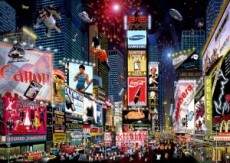
From Broadway To 52nd Street
As our final installment on the musicals and the songs that have gone on to become classics in the jazz catalogue, Broadway has entertained millions of audiences from around the world and has touched every human emotion and story one can imagine. It has captured our hearts and taken us on journeys to unexpected destinations both visceral and intuitive.
The Broadway musical played an integral role in the creation of the Great American Songbook as songs from the legendary composers and lyricists like Gershwin, Porter, KernRodgers, Hammerstein, Van Heusen, Hart, Webber, Rice, Loesser, Bricusse, Newley, Styne, Comden etc. have filled the pages of our imaginations
The “blockbuster” musicals were so successful that they ran over a thousand performances. A small aggregation of only 17 comprised of Oklahoma (2,212), Annie Get Your Gun (1,147), Kiss Me Kate (1,077), South Pacific (1,925), Guys & Dolls (1,200), The King And I (1,246), The Pajama Game (1,063), My Fair Lady (2,717), How To Succeed In Business (1,417), Funny Girl (1,348), Hello Dolly (2,844), Fiddler On The Roof (3,242), The Sound Of Music (1,443), Mame (1,508), Promises, Promises (1,281), Ain’t Misbehavin’ (1,604) and Evita (1,567).
To describe Broadway one would beg permission to borrow from Tevya in Fiddler On The Roof – “without tradition our lives would be as shaky as a fiddler on the roof!”
The lyrics and composition that were relegated to the amphitheaters of “The Great White Way” have received perpetual encores over the past century under the auspices of “The Street” and the songs continue to be honored by living legends, contemporaries and the “new breed” of jazz musicians and vocalists.
52nd Street, between Fifth and Seventh Avenues was known as “Swing Street” was equally attended by hundreds of thousands during its heyday between the 1930s and 1950s in just thirteen clubs. Equally blockbuster are the million selling albums of Miles Davis (Kind of Blue), Dave Brubeck (Time Out), John Coltrane (A Love Supreme, Blue Train), Herbie Hancock (Headhunters), Louis Armstrong (What A Wonderful World), Ella Fitzgerald (Best of the Songbooks).
To describe 52nd Street one would merely state that it was the epicenter of jazz in New York City and the connection between the musicians who played on Broadway and the legitimate clubs. It was the place where musicians who played for others earlier in the night, played for themselves on 52nd Street.



